STOREPapers WP ISSN 2282-0299
[:en]STOREPapers WP 2 2022
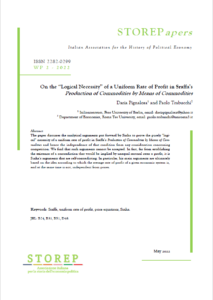 Daria PIGNALOSA and Paolo TRABUCCHI, “On the “Logical Necessity” of a Uniform Rate of Profit in Sraffa’s Production of Commodities by Means of Commodities“
Daria PIGNALOSA and Paolo TRABUCCHI, “On the “Logical Necessity” of a Uniform Rate of Profit in Sraffa’s Production of Commodities by Means of Commodities“
The paper discusses the analytical arguments put forward by Sinha to prove the purely “logical” necessity of a uniform rate of profit in Sraffa’s Production of Commodities by Means of Commodities and hence the independence of that condition from any consideration concerning competition. We find that such arguments cannot be accepted. In fact, far from establishing the existence of a contradiction that would be implied by unequal sectoral rates o profit, it is Sinha’s arguments that are self-contradicting. In particular, his main arguments are ultimately based on the idea according to which the average rate of profit of a given economic system is, and at the same time is not, independent from prices.
Keywords: Sraffa, uniform rate of profit, price equations, Sinha
JEL: B24, B31, B51, D46
[Download]
STOREPapers WP 1 2022
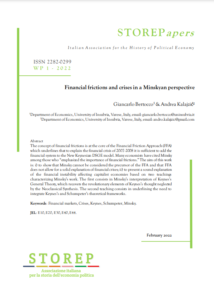 Giancarlo BERTOCCO & Andrea KALAJZIĆ, “Financial frictions and crises in a Minskyan perspective“
Giancarlo BERTOCCO & Andrea KALAJZIĆ, “Financial frictions and crises in a Minskyan perspective“
The concept of financial frictions is at the core of the Financial Friction Approach (FFA) which underlines that to explain the financial crisis of 2007-2008 it is sufficient to add the financial system to the New Keynesian DSGE model. Many economists have cited Minsky among those who “emphasized the importance of financial frictions.” The aim of this work is: i) to show that Minsky cannot be considered the precursor of the FFA and that FFA does not allow for a solid explanation of financial crises; ii) to present a sound explanation of the financial instability affecting capitalist economies based on two teachings characterizing Minsky’s work. The first consists in Minsky’s interpretation of Keynes’s General Theory, which recovers the revolutionary elements of Keynes’s thought neglected by the Neoclassical Synthesis. The second teaching consists in underlining the need to integrate Keynes’s and Schumpeter’s theoretical frameworks.
Keywords: Financial markets, Crises, Keynes, Schumpeter, Minsky
JEL: E10, E20, E30, E40, E44
[Download]
STOREPapers WP 2 2021
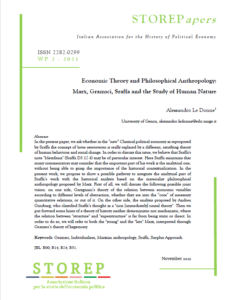 Alessandro LE DONNE, “Economic Theory and Philosophical Anthropology: Marx, Gramsci, Sraffa and the Study of Human Nature“
Alessandro LE DONNE, “Economic Theory and Philosophical Anthropology: Marx, Gramsci, Sraffa and the Study of Human Nature“
In the present paper, we ask whether in the “new” Classical political economy as reproposed by Sraffa the concept of homo oeconomicus is really replaced by a different, satisfying theory of human behaviour and social change. In order to discuss this issue, we believe that Sraffa’s note “Metafisica” (Sraffa D3.12.4) may be of particular interest. Here Sraffa maintains that many commentators may consider that the important part of his work is the analytical one, without being able to grasp the importance of the historical contextualization. In the present work, we propose to show a possible pathway to integrate the analytical part of Sraffa’s work with the historical analysis based on the materialist philosophical anthropology proposed by Marx. First of all, we will discuss the following possible joint vision: on one side, Garegnani’s theory of the relation between economic variables according to different levels of abstraction, whether they are into the “core” of necessary quantitative relations, or out of it. On the other side, the analysis proposed by Andrea Ginzburg, who classified Sraffa’s thought as a “non [immediately] causal theory”. Then we put forward some hints of a theory of history neither deterministic nor mechanistic, where the relation between “structure” and “superstructure” is far from being static or direct. In order to do so, we will refer to both the “young” and the “late” Marx, interpreted through Gramsci’s theory of hegemony.
Keywords: Gramsci, Individualism, Marxian anthropology, Sraffa, Surplus Approach
JEL: B00; B14; B24; B51
[Download]
STOREPapers WP 1 2021
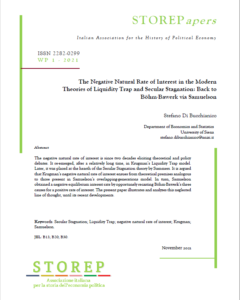 Stefano DI BUCCHIANICO, “The Negative Natural Rate of Interest in the Modern Theories of Liquidity Trap and Secular Stagnation: Back to Böhm-Bawerk via Samuelson“
Stefano DI BUCCHIANICO, “The Negative Natural Rate of Interest in the Modern Theories of Liquidity Trap and Secular Stagnation: Back to Böhm-Bawerk via Samuelson“
The negative natural rate of interest is since two decades eliciting theoretical and policy debates. It re-emerged, after a relatively long time, in Krugman’s Liquidity Trap model. Later, it was placed at the hearth of the Secular Stagnation theory by Summers. It is argued that Krugman’s negative natural rate of interest ensues from theoretical premises analogous to those present in Samuelson’s overlapping-generations model. In turn, Samuelson obtained a negative equilibrium interest rate by opportunely recasting Böhm-Bawerk’s three causes for a positive rate of interest. The present paper illustrates and analyses this neglected line of thought, until its recent developments.
Keywords: Secular Stagnation; Liquidity Trap; negative natural rate of interest; Krugman; Samuelson
JEL: B13; B20; B30
[Download]
STOREPapers WP 1 2019
 Agnès LE TOLLEC, “Home Economics as an Art of Improving Family Welfare: Creating a Rational Consumer, 1924-1945“
Agnès LE TOLLEC, “Home Economics as an Art of Improving Family Welfare: Creating a Rational Consumer, 1924-1945“
This article focuses on home economists’ efforts to educate women to rational consumption from the 1920s to the end of World War II. Using the publications of key home economists who were active in the field of consumer and family economics – namely Hazel Kyrk, Elizabeth Hoyt and Margaret Reid – I argue that their interest in rationalizing consumption emerged as an effort to counterbalance the negative influence of corporations on consumers. Home economists proposed to direct consumer’s spending – like advertisers did – but from a welfare standpoint. Then I analyze home economists’ institutional and intellectual influence in federal government, consumer organizations as well as in education from the early 1930s to 1945. I argue that home economists were instrumental in building a new image of the woman consumer as an individual who could be made more rational thanks to scientific and technical information.
Keywords: : home economics, consumer rationality, advertising, consumer education
JEL: B29, D10
[Download]
STOREPapers WP 2 2018
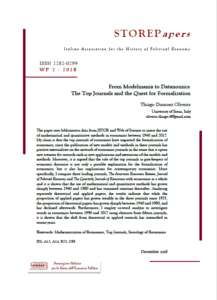 Thiago Dumont OLIVEIRA, “From Modelmania to Datanomics: The Top Journals and the Quest for Formalization“
Thiago Dumont OLIVEIRA, “From Modelmania to Datanomics: The Top Journals and the Quest for Formalization“
The paper uses bibliometric data from JSTOR and Web of Science to assess the rise of mathematical and quantitative methods in economics between 1940 and 2017. My claim is that the top journals of economics have impacted the formalization of economics, since the publication of new models and methods in these journals has positive externalities on the network of economics journals in the sense that it opens new avenues for research such as new applications and extensions of the models and methods. Moreover, it is argued that the role of the top journals as gate-keepers of economic discourse is not only a possible explanation for the formalization of economics, but it also has implications for contemporary economics. More specifically, I compare three leading journals, The American Economic Review, Journal of Political Economy and The Quarterly Journal of Economics with economics as a whole and it is shown that the use of mathematical and quantitative methods has grown sharply between 1940 and 1980 and has remained constant thereafter. Analyzing separately theoretical and applied papers, the results indicate that while the proportion of applied papers has grown steadily in the three journals since 1955, the proportion of theoretical papers has grown sharply between 1940 and 1980, and has declined afterwards. Furthermore, I employ co-word analysis to investigate trends in economics between 1990 and 2017 using abstracts from fifteen journals, it is shown that the shift from theoretical to applied research has intensified in recent years.
Keywords: Mathematization of Economics, Top Journals, Sociology of Economics
JEL: A11, A14, B23, C88
[Download]
STOREPapers WP 1 2018
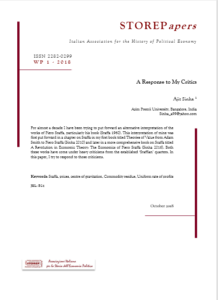 Ajit SINHA, “A Response to My Critics“
Ajit SINHA, “A Response to My Critics“
For almost a decade I have been trying to put forward an alternative interpretation of the works of Piero Sraffa, particularly his book (Sraffa 1960). This interpretation of mine was first put forward in a chapter on Sraffa in my first book titled Theories of Value from Adam Smith to Piero Sraffa (Sinha 2010) and later in a more comprehensive book on Sraffa titled A Revolution in Economic Theory: The Economics of Piero Sraffa (Sinha 2016). Both these works have come under heavy criticisms from the established ‘Sraffian’ quarters. In this paper, I try to respond to those criticisms.
Keywords: Sraffa, prices, centre of gravitation, Commodity residue, Uniform rate of profits
JEL: B24
[Download]
STOREPapers WP 4 2017
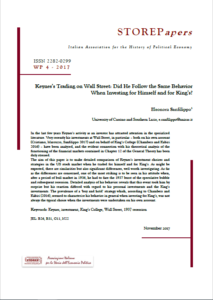 Eleonora SANFILIPPO, “Keynes’s Trading on Wall Street: Did He Follow the Same Behavior When Investing for Himself and for King’s?“
Eleonora SANFILIPPO, “Keynes’s Trading on Wall Street: Did He Follow the Same Behavior When Investing for Himself and for King’s?“
In the last few years Keynes’s activity as an investor has attracted attention in the specialized literature. Very recently his investments at Wall Street, in particular – both on his own account (Cristiano, Marcuzzo, Sanfilippo 2017) and on behalf of King’s College (Chambers and Kabiri 2016) – have been analyzed, and the evident connection with his theoretical analysis of the functioning of the financial markets contained in Chapter 12 of the General Theory has been duly stressed.
The aim of this paper is to make detailed comparison of Keynes’s investment choices and strategies in the US stock market when he traded for himself and for King’s. As might be expected, there are similarities but also significant differences, well worth investigating. As far as the differences are concerned, one of the most striking is to be seen in his attitude when, after a period of bull market in 1936, he had to face the 1937 burst of the speculative bubble and subsequent recession. Detailed analysis of his behavior reveals that this event took him by surprise but his reaction differed with regard to his personal investments and the King’s investments. The prevalence of a ‘buy and hold’ strategy which, according to Chambers and Kabiri (2016), seemed to characterize his behavior in general when investing for King’s, was not always the typical choice when the investments were undertaken on his own account.
Keywords: Keynes, investment, King’s College, Wall Street, 1937 recession
JEL: B26, B31, G11, N22
[Download]
STOREPapers WP 3 2017
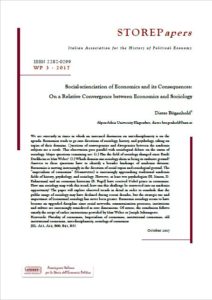 Dieter BÖGENHOLD, “Social-scienciation of Economics and its Consequences: On a Relative Convergence between Economics and Sociology“
Dieter BÖGENHOLD, “Social-scienciation of Economics and its Consequences: On a Relative Convergence between Economics and Sociology“
We are currently in times in which an increased discussion on interdisciplinarity is on the agenda. Economics tends to go into directions of sociology, history, and psychology, taking on topics of their domains. Questions of convergencies and divergencies between the academic subjects are a result. This observation goes parallel with sociological debate on the status of sociology. Major questions remaining are: (1.) Has the field of sociology changed since Emilé Durkheim or Max Weber? (2.) Which domain can sociology claim as being its exclusive ground? Answers to these questions have to identify a broader landscape of academic division: Economics is moving increasingly in the direction of social topics and sociological ground. The “imperialism of economics” (Granovetter) is increasingly approaching traditional academic fields of history, psychology, and sociology. However, at least two psychologists (H. Simon, D. Kahneman) and an economic historian (R. Fogel) have received Nobel prizes in economics. How can sociology map with this trend, how can this challenge be converted into an academic opportunity? The paper will explore observed trends in detail in order to conclude that the public image of sociology may have declined during recent decades, but the strategic use and importance of (economic) sociology has never been greater. Economic sociology seems to have become an upgraded discipline since social networks, communication processes, institutions and culture are increasingly considered as core dimensions. Of course, the conclusion follows exactly the script of earlier instructions provided by Max Weber or Joseph Schumpeter.
Keywords: Pluralism in economics, Imperialism of economics, institutional economics, old institutional economics, interdisciplinarity, sociology of economics
JEL: A11, A14, B00, B41, B52
[Download]
STOREPapers WP 2 2017
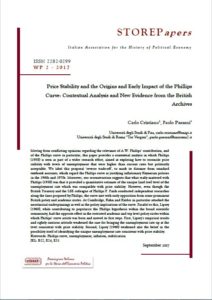 Carlo CRISTIANO and Paolo PAESANI, “Price Stability and the Origins and Early Impact of the Phillips Curve: Contextual Analysis and New Evidence from the British Archives“
Carlo CRISTIANO and Paolo PAESANI, “Price Stability and the Origins and Early Impact of the Phillips Curve: Contextual Analysis and New Evidence from the British Archives“
Moving from conflicting opinions regarding the relevance of A.W. Phillips’ contribution, and of the Phillips curve in particular, this paper provides a contextual analysis in which Phillips (1958) is seen as part of a wider research effort, aimed at exploring how to reconcile price stability with levels of unemployment that were higher than current rates but politically acceptable. We label this proposal ‘reverse trade-off’, to mark its distance from standard textbook accounts, which regard the Phillips curve as justifying inflationary Keynesian policies in the 1960s and 1970s. Moreover, our reconstruction suggests that what really mattered with Phillips (1958) was that it provided a quantitative estimate of the unique (and low) level of the unemployment rate which was compatible with price stability. However, even though the British Treasury and the LSE colleague of Phillips F. Paish conducted independent researches along the lines proposed by Phillips, the curve met with early opposition from some prominent British policy and academic circles. At Cambridge, Kahn and Kaldor in particular attacked the neoclassical underpinnings as well as the policy implications of the curve. Parallel to this, Lipsey (1960), while contributing to popularize the Phillips hypothesis within the broad scientific community, had the opposite effect in the restricted academic and top level policy circles within which Phillips’ curve article was born and moved its first steps. First, Lipsey’s empirical results and rightly cautious attitude weakened the case for bringing the unemployment rate up at the level consistent with price stability. Second, Lipsey (1960) weakened also the belief in the possibility itself of identifying the unique unemployment rate consistent with price stability.
Keywords: Phillips curve, unemployment, inflation, stabilization.
JEL: B22, E24, E31
[Download]
STOREPapers WP 1 2017
Angela AMBROSINO, “The Role of Agents’ Propensity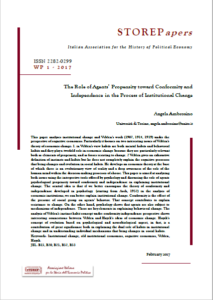 toward Conformity and Independence in the Process of Institutional Change“
toward Conformity and Independence in the Process of Institutional Change“
This paper analyses institutional change and Veblen’s work (1907, 1914, 1919) under the perspective of cognitive economics. Particularly it focuses on two interesting issues of Veblen’s theory of economic change: 1. in Veblen’s view habits are both mental habits and behavioral habits and they play a twofold role in economic change because they are particularly relevant both as elements of propensity, and as forces resisting to change. 2 Veblen gives an exhaustive definition of instincts and habits but he does not completely explain the cognitive processes that bring changes and evolution in social habits. He develops an economic theory at the base of which there is an evolutionary view of reality and a deep awareness of the role of the human mind within the decision-making processes of choice. This paper is aimed at analyzing both issues using the interpretive tools offered by psychology and discussing the role of agents psychological propensity toward conformity and independence in explaining institutional change. The central idea is that if we better encompass the theory of conformity and independence developed in psychology (starting from Asch, 1952) in the analysis of economic institutions, we can better explain institutional change. Conformity is the effect of the pressure of social group on agents’ behavior. That concept contributes to explain resistance to change. On the other hand, psychology shows that agents are also subject to mechanisms of independence. These are key elements in explaining behavioral change. The analysis of Veblen’s instinct-habit concept under conformity-independence perspective shows interesting connections between Veblen and Hayek’s ideas of economic change. Hayek’s concept of evolution based on psychological and neurobiological aspect, in fact, is a contribution of great significance both in explaining the dual role of habits in institutional change and in understanding individual mechanisms that bring changes in social habits.
Keywords: Institutional change, old institutional economics, cognitive economics, Veblen, Hayek.
JEL: B15, B20, B25; B52, B53
[Download]
STOREPapers 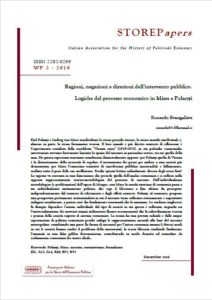 WP 2 2016
WP 2 2016
Riccardo EVANGELISTA, “Ragioni, negazioni e direzioni dell’intervento pubblico. Logiche del processo economico in Mises e Polanyi“
Karl Polanyi e Ludwig von Mises condividono lo stesso periodo storico, lo stesso mondo intellettuale e, almeno in parte, la stessa formazione teorica. Il loro iniziale e più diretto contesto di riflessione è l’esperimento socialista della cosiddetta “Vienna rossa” (1919-1933), in cui politiche economiche interventiste avevano fortemente limitato lo spazio del mercato in particolari settori, tra cui quello della casa. Da questa esperienza trarranno conclusioni diametralmente opposte: per Polanyi quella di Vienna è la dimostrazione della necessità di regolare il meccanismo dei prezzi per ambire a una società più democratica, per Mises l’ennesimo tentativo di interferenza pubblica insostenibile e fallimentare, crollato sotto il peso delle sue inefficienze. Perché questa lettura radicalmente diversa degli stessi fatti? La ragione va ricercata in una dimensione che precede quella dell’analisi economica e si colloca nella opposta rappresentazione storico-metodologica del processo di mercato. Dall’individualismo metodologico (e problematico) dell’opera di Menger, con Mises la scuola austriaca di economia passa a un individualismo intimamente politico, che erge il liberismo a fine ultimo da perseguire indipendentemente dal contesto di riferimento e dagli effetti concreti. Polanyi, al contrario, propone una prospettiva prettamente istituzionalista in cui il mercato viene collocato storicamente e soprattutto indagato socialmente, a partire cioè dai fondamenti eccezionali che lo animano. Lo studioso ungherese fa dunque dipendere l’azione individuale dal tipo di società in cui questa è collocata, negando sia l’universalizzazione dei moventi umani utilitaristici (homo oeconomicus) che la subordinazione teorica e pratica della società rispetto al sistema economico. La critica ha una portata radicale e dalle ampie ripercussioni di politica economica perché indaga le rappresentazioni mentali alla base del mercato autoregolato: scambiando una parte (la forma di mercato) per l’intera economia umana (i diversi modi in cui le società hanno risolto il problema della sussistenza), la teoria liberista rinchiude fatalmente l’umanità in una falsa gabbia deterministica, contribuendo in modo decisivo ad ostacolare «la realizzazione economica dei nostri ideali».
Keywords: Polanyi, Mises, mercato, sostantivismo, formalismo
JEL: A13, A14, B40, B52, B53
[Download]
STOREPapers 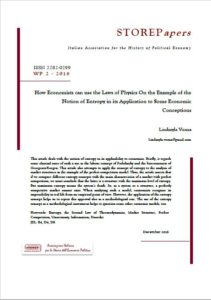 WP 1 2016
WP 1 2016
Liudmyla VOZNA, “How Economists Can Use the Laws of Physics On the Example of the Notion of Entropy in its Application to Some Economic Conceptions“
This article deals with the notion of entropy in its applicability to economics. Briefly, it regards some classical cases of such a use as the labour concept of Podolinsky and the bioeconomics of Georgescu-Roegen. This article also attempts to apply the concept of entropy to the analysis of market structures in the example of the perfect competition model. Thus, the article asserts that if we compare different entropy concepts with the main characteristics of a market with perfect competition, we must conclude that the latter is a structure with the maximum level of entropy. But maximum entropy means the system’s death. So, as a system or a structure, a perfectly competitive market cannot exist. When analysing such a model, economists recognise its impossibility in real life from an empirical point of view. However, the application of the entropy concept helps us to repeat this approval also as a methodological one. The use of the entropy concept as a methodological instrument helps to question some other economic models, too.
Keywords: Entropy, the Second Law of Thermodynamics, Market Structure, Perfect Competition, Uncertainty, Information, Disorder
JEL: B4, D4, D8
[Download]
STOREPapers WP 5 2015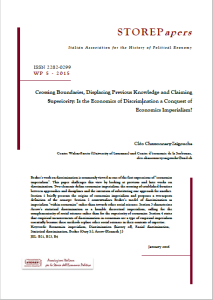
Cléo CHASSONNERY-ZAÏGOUCHE, “Crossing Boundaries, Displacing Previous Knowledge and Claiming Superiority: Is the Economics of Discrimination a Conquest of Economics Imperialism?“
Becker’s work on discrimination is commonly viewed as one of the first expressions of “economics imperialism”. This paper challenges this view by looking at previous and later works on discrimination. Two elements define economics imperialism: the crossing of established frontiers between approaches and disciplines and the intention of substituting one approach for another. Section 1 briefly presents the origins of economics imperialism and proposes a two-aspects definition of the concept. Section 2 contextualizes Becker’s model of discrimination as imperialism “within economics” rather than towards other social sciences. Section 3 characterizes Arrow’s statistical discrimination as a humble theoretical imperialism, calling for the complementarity of social sciences rather than for the superiority of economics. Section 4 states that empirical measurements of discrimination in economics are a type of empirical imperialism essentially because these methods replace other social sciences in their contexts of expertise.
Keywords: Economics imperialism, Discrimination (history of), Racial discrimination, Statistical discrimination, Becker (Gary S.), Arrow (Kenneth J.)
JEL: B21, B23, B4
[Download]
STOREPapers 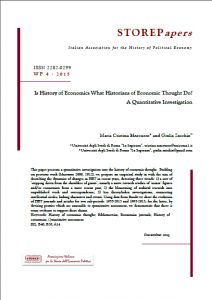 WP 4 2015
WP 4 2015
Maria Cristina MARCUZZO and Giulia ZACCHIA, “Is History of Economics What Historians of Economic Thought Do? A Quantitative Investigation”
This paper presents a quantitative investigation into the history of economic thought. Building on previous work (Marcuzzo 2008, 2012), we propose an empirical study in with the aim of describing the dynamics of changes in HET in recent years, detecting three trends: 1) a sort of ‘stepping down from the shoulders of giants’, namely a move towards studies of ‘minor’ figures and/or economists from a more recent past; 2) the blossoming of archival research into unpublished work and correspondence; 3) less theory-laden investigations, connecting intellectual circles, linking characters and events. Using data from Econlit we show the evolution of HET journals and articles for two sub-periods: 1955-2013 and 1993-2013; for the latter, by devising proxies which are amenable to quantitative assessment, we demonstrate that there is some evidence to support these claims.
Keywords: History of economic thought; Bibliometrics; Economics journals; History of economics; Quantitative assessment
JEL: B40, B20, A14
[Download]
STOREPapers WP 3 2015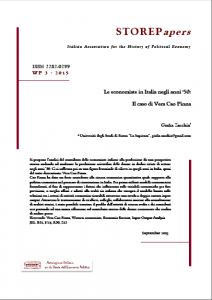
Giulia ZACCHIA, “Le economiste in Italia negli anni ‘50: Il caso di Vera Cao Pinna”
Si propone l’analisi del contributo delle economiste italiane alla professione da una prospettiva storica andando ad analizzare la produzione scientifica delle donne in dodici riviste di settore negli anni ’50. Ci si sofferma poi su una figura femminile di rilievo in quegli anni in Italia, quasi del tutto dimenticata: Vera Cao Pinna.
Cao Pinna ha dato un forte contributo alla ricerca economica quantitativa quale supporto alla politica economica nel processo di ricostruzione in Italia. Per prima utilizzò modelli econometrici formalizzati, al fine di rappresentare i fattori che influiscono sulle variabili economiche per fare previsioni, o meglio affinò e adattò alla realtà sia italiana che europea il modello basato sulle relazioni tra i settori di attività economica ricavabili attraverso una tavola a doppia entrata input-output. Attraverso le testimonianze di ex allievi, colleghi, collaboratori insieme alla consultazione di archivi storici, è stato possibile tracciare il profilo dell’attività di ricerca svolta e dei contributi resi portando ad una amara riflessione sul contributo storico delle donne economiste che rischia di andare perso.
Keywords: Vera Cao Pinna, Women economists, Economic forecast, Input Output Analysis
JEL: B31, N14, R50, Z13
[Download]
STOREPapers WP 2 2015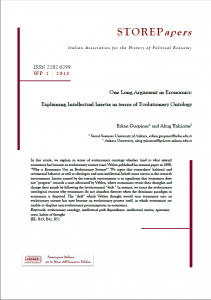
Erkan GURPINAR & Altug YALCINTAS, “One Long Argument in Economics: Explaining Intellectual Inertia in terms of Evolutionary Ontology”
In this article, we explain in terms of evolutionary ontology whether (and to what extent) economics has become an evolutionary science since Veblen published his seminal paper in 1898, “Why is Economics Not an Evolutionary Science?” We argue that researchers’ habitual and ceremonial behavior as well as ideologies and non-intellectual beliefs cause inertia in the research environment. Inertia caused by the research environment is so significant that economics does not “progress” towards a state advocated by Veblen, where economists revisit their thoughts and change their minds by following the (evolutionary) “drift.” In essence, we stress the evolutionary ontological reasons why economists do not abandon theories when the dominant paradigm in economics is disputed. The “drift” which Veblen thought would turn economics into an evolutionary science has now become an evolutionary process itself, in which economists are unable to displace non-evolutionary preconceptions in economics.
Keywords: evolutionary ontology, intellectual path dependence, intellectual inertia, epistemic costs, habits of thought
JEL: B15, B41, B52
[Download]
STOREPapers WP 4 2014
Public goods and commons, some preliminary reflections, Sofia COSTANZA
STOREPapers WP 2 2014
Securitization, Fragility, and Regulation, Antonio BIANCO
STOREPapers WP 12 2013
The Commons, Trust and Community Governance, Sofia COSTANZA
STOREPapers WP 9 2013
Fausto Vicarelli e la controversia keynesiana, Giovanni MICHELAGNOLI
STOREPapers WP 7 2013
Hicks’s thread (out of the equilibrium labyrinth), Antonio BIANCO
STOREPapers WP 2 2013
F.A. Hayek’s The Sensory Order An evolutionary perspective, Jack BIRNER
STOREPapers WP 1 2013
Ragnar Frisch e la nozione di equilibrio normale, Paolo TRABUCCHI[:it]STOREPapers WP 2 2022
 Daria PIGNALOSA and Paolo TRABUCCHI, “On the “Logical Necessity” of a Uniform Rate of Profit in Sraffa’s Production of Commodities by Means of Commodities“
Daria PIGNALOSA and Paolo TRABUCCHI, “On the “Logical Necessity” of a Uniform Rate of Profit in Sraffa’s Production of Commodities by Means of Commodities“
The paper discusses the analytical arguments put forward by Sinha to prove the purely “logical” necessity of a uniform rate of profit in Sraffa’s Production of Commodities by Means of Commodities and hence the independence of that condition from any consideration concerning competition. We find that such arguments cannot be accepted. In fact, far from establishing the existence of a contradiction that would be implied by unequal sectoral rates o profit, it is Sinha’s arguments that are self-contradicting. In particular, his main arguments are ultimately based on the idea according to which the average rate of profit of a given economic system is, and at the same time is not, independent from prices.
Keywords: Sraffa, uniform rate of profit, price equations, Sinha
JEL: B24, B31, B51, D46
[Download]
STOREPapers WP 1 2022
 Giancarlo BERTOCCO & Andrea KALAJZIĆ, “Financial frictions and crises in a Minskyan perspective“
Giancarlo BERTOCCO & Andrea KALAJZIĆ, “Financial frictions and crises in a Minskyan perspective“
The concept of financial frictions is at the core of the Financial Friction Approach (FFA) which underlines that to explain the financial crisis of 2007-2008 it is sufficient to add the financial system to the New Keynesian DSGE model. Many economists have cited Minsky among those who “emphasized the importance of financial frictions.” The aim of this work is: i) to show that Minsky cannot be considered the precursor of the FFA and that FFA does not allow for a solid explanation of financial crises; ii) to present a sound explanation of the financial instability affecting capitalist economies based on two teachings characterizing Minsky’s work. The first consists in Minsky’s interpretation of Keynes’s General Theory, which recovers the revolutionary elements of Keynes’s thought neglected by the Neoclassical Synthesis. The second teaching consists in underlining the need to integrate Keynes’s and Schumpeter’s theoretical frameworks.
Keywords: Financial markets, Crises, Keynes, Schumpeter, Minsky
JEL: E10, E20, E30, E40, E44
[Download]
STOREPapers WP 2 2021
 Alessandro LE DONNE, “Economic Theory and Philosophical Anthropology: Marx, Gramsci, Sraffa and the Study of Human Nature“
Alessandro LE DONNE, “Economic Theory and Philosophical Anthropology: Marx, Gramsci, Sraffa and the Study of Human Nature“
In the present paper, we ask whether in the “new” Classical political economy as reproposed by Sraffa the concept of homo oeconomicus is really replaced by a different, satisfying theory of human behaviour and social change. In order to discuss this issue, we believe that Sraffa’s note “Metafisica” (Sraffa D3.12.4) may be of particular interest. Here Sraffa maintains that many commentators may consider that the important part of his work is the analytical one, without being able to grasp the importance of the historical contextualization. In the present work, we propose to show a possible pathway to integrate the analytical part of Sraffa’s work with the historical analysis based on the materialist philosophical anthropology proposed by Marx. First of all, we will discuss the following possible joint vision: on one side, Garegnani’s theory of the relation between economic variables according to different levels of abstraction, whether they are into the “core” of necessary quantitative relations, or out of it. On the other side, the analysis proposed by Andrea Ginzburg, who classified Sraffa’s thought as a “non [immediately] causal theory”. Then we put forward some hints of a theory of history neither deterministic nor mechanistic, where the relation between “structure” and “superstructure” is far from being static or direct. In order to do so, we will refer to both the “young” and the “late” Marx, interpreted through Gramsci’s theory of hegemony.
Keywords: Gramsci, Individualism, Marxian anthropology, Sraffa, Surplus Approach
JEL: B00; B14; B24; B51
[Download]
STOREPapers WP 1 2021
 Stefano DI BUCCHIANICO, “The Negative Natural Rate of Interest in the Modern Theories of Liquidity Trap and Secular Stagnation: Back to Böhm-Bawerk via Samuelson“
Stefano DI BUCCHIANICO, “The Negative Natural Rate of Interest in the Modern Theories of Liquidity Trap and Secular Stagnation: Back to Böhm-Bawerk via Samuelson“
The negative natural rate of interest is since two decades eliciting theoretical and policy debates. It re-emerged, after a relatively long time, in Krugman’s Liquidity Trap model. Later, it was placed at the hearth of the Secular Stagnation theory by Summers. It is argued that Krugman’s negative natural rate of interest ensues from theoretical premises analogous to those present in Samuelson’s overlapping-generations model. In turn, Samuelson obtained a negative equilibrium interest rate by opportunely recasting Böhm-Bawerk’s three causes for a positive rate of interest. The present paper illustrates and analyses this neglected line of thought, until its recent developments.
Keywords: Secular Stagnation; Liquidity Trap; negative natural rate of interest; Krugman; Samuelson
JEL: B13; B20; B30
[Download]
STOREPapers WP 1 2019
 Agnès LE TOLLEC, “Home Economics as an Art of Improving Family Welfare: Creating a Rational Consumer, 1924-1945“
Agnès LE TOLLEC, “Home Economics as an Art of Improving Family Welfare: Creating a Rational Consumer, 1924-1945“
This article focuses on home economists’ efforts to educate women to rational consumption from the 1920s to the end of World War II. Using the publications of key home economists who were active in the field of consumer and family economics – namely Hazel Kyrk, Elizabeth Hoyt and Margaret Reid – I argue that their interest in rationalizing consumption emerged as an effort to counterbalance the negative influence of corporations on consumers. Home economists proposed to direct consumer’s spending – like advertisers did – but from a welfare standpoint. Then I analyze home economists’ institutional and intellectual influence in federal government, consumer organizations as well as in education from the early 1930s to 1945. I argue that home economists were instrumental in building a new image of the woman consumer as an individual who could be made more rational thanks to scientific and technical information.
Keywords: : home economics, consumer rationality, advertising, consumer education
JEL: B29, D10
[Download]
STOREPapers WP 2 2018
 Thiago Dumont OLIVEIRA, “From Modelmania to Datanomics: The Top Journals and the Quest for Formalization“
Thiago Dumont OLIVEIRA, “From Modelmania to Datanomics: The Top Journals and the Quest for Formalization“
The paper uses bibliometric data from JSTOR and Web of Science to assess the rise of mathematical and quantitative methods in economics between 1940 and 2017. My claim is that the top journals of economics have impacted the formalization of economics, since the publication of new models and methods in these journals has positive externalities on the network of economics journals in the sense that it opens new avenues for research such as new applications and extensions of the models and methods. Moreover, it is argued that the role of the top journals as gate-keepers of economic discourse is not only a possible explanation for the formalization of economics, but it also has implications for contemporary economics. More specifically, I compare three leading journals, The American Economic Review, Journal of Political Economy and The Quarterly Journal of Economics with economics as a whole and it is shown that the use of mathematical and quantitative methods has grown sharply between 1940 and 1980 and has remained constant thereafter. Analyzing separately theoretical and applied papers, the results indicate that while the proportion of applied papers has grown steadily in the three journals since 1955, the proportion of theoretical papers has grown sharply between 1940 and 1980, and has declined afterwards. Furthermore, I employ co-word analysis to investigate trends in economics between 1990 and 2017 using abstracts from fifteen journals, it is shown that the shift from theoretical to applied research has intensified in recent years.
Keywords: Mathematization of Economics, Top Journals, Sociology of Economics
JEL: A11, A14, B23, C88
[Download]
STOREPapers WP 1 2018
 Ajit SINHA, “A Response to My Critics“
Ajit SINHA, “A Response to My Critics“
For almost a decade I have been trying to put forward an alternative interpretation of the works of Piero Sraffa, particularly his book (Sraffa 1960). This interpretation of mine was first put forward in a chapter on Sraffa in my first book titled Theories of Value from Adam Smith to Piero Sraffa (Sinha 2010) and later in a more comprehensive book on Sraffa titled A Revolution in Economic Theory: The Economics of Piero Sraffa (Sinha 2016). Both these works have come under heavy criticisms from the established ‘Sraffian’ quarters. In this paper, I try to respond to those criticisms.
Keywords: Sraffa, prices, centre of gravitation, Commodity residue, Uniform rate of profits
JEL: B24
[Download]
STOREPapers WP 4 2017
 Eleonora SANFILIPPO, “Keynes’s Trading on Wall Street: Did He Follow the Same Behavior When Investing for Himself and for King’s?“
Eleonora SANFILIPPO, “Keynes’s Trading on Wall Street: Did He Follow the Same Behavior When Investing for Himself and for King’s?“
In the last few years Keynes’s activity as an investor has attracted attention in the specialized literature. Very recently his investments at Wall Street, in particular – both on his own account (Cristiano, Marcuzzo, Sanfilippo 2017) and on behalf of King’s College (Chambers and Kabiri 2016) – have been analyzed, and the evident connection with his theoretical analysis of the functioning of the financial markets contained in Chapter 12 of the General Theory has been duly stressed.
The aim of this paper is to make detailed comparison of Keynes’s investment choices and strategies in the US stock market when he traded for himself and for King’s. As might be expected, there are similarities but also significant differences, well worth investigating. As far as the differences are concerned, one of the most striking is to be seen in his attitude when, after a period of bull market in 1936, he had to face the 1937 burst of the speculative bubble and subsequent recession. Detailed analysis of his behavior reveals that this event took him by surprise but his reaction differed with regard to his personal investments and the King’s investments. The prevalence of a ‘buy and hold’ strategy which, according to Chambers and Kabiri (2016), seemed to characterize his behavior in general when investing for King’s, was not always the typical choice when the investments were undertaken on his own account.
Keywords: Keynes, investment, King’s College, Wall Street, 1937 recession
JEL: B26, B31, G11, N22
[Download]
STOREPapers WP 3 2017
 Dieter BÖGENHOLD, “Social-scienciation of Economics and its Consequences: On a Relative Convergence between Economics and Sociology“
Dieter BÖGENHOLD, “Social-scienciation of Economics and its Consequences: On a Relative Convergence between Economics and Sociology“
We are currently in times in which an increased discussion on interdisciplinarity is on the agenda. Economics tends to go into directions of sociology, history, and psychology, taking on topics of their domains. Questions of convergencies and divergencies between the academic subjects are a result. This observation goes parallel with sociological debate on the status of sociology. Major questions remaining are: (1.) Has the field of sociology changed since Emilé Durkheim or Max Weber? (2.) Which domain can sociology claim as being its exclusive ground? Answers to these questions have to identify a broader landscape of academic division: Economics is moving increasingly in the direction of social topics and sociological ground. The “imperialism of economics” (Granovetter) is increasingly approaching traditional academic fields of history, psychology, and sociology. However, at least two psychologists (H. Simon, D. Kahneman) and an economic historian (R. Fogel) have received Nobel prizes in economics. How can sociology map with this trend, how can this challenge be converted into an academic opportunity? The paper will explore observed trends in detail in order to conclude that the public image of sociology may have declined during recent decades, but the strategic use and importance of (economic) sociology has never been greater. Economic sociology seems to have become an upgraded discipline since social networks, communication processes, institutions and culture are increasingly considered as core dimensions. Of course, the conclusion follows exactly the script of earlier instructions provided by Max Weber or Joseph Schumpeter.
Keywords: Pluralism in economics, Imperialism of economics, institutional economics, old institutional economics, interdisciplinarity, sociology of economics
JEL: A11, A14, B00, B41, B52
[Download]
STOREPapers WP 2 2017
 Carlo CRISTIANO and Paolo PAESANI, “Price Stability and the Origins and Early Impact of the Phillips Curve: Contextual Analysis and New Evidence from the British Archives“
Carlo CRISTIANO and Paolo PAESANI, “Price Stability and the Origins and Early Impact of the Phillips Curve: Contextual Analysis and New Evidence from the British Archives“
Moving from conflicting opinions regarding the relevance of A.W. Phillips’ contribution, and of the Phillips curve in particular, this paper provides a contextual analysis in which Phillips (1958) is seen as part of a wider research effort, aimed at exploring how to reconcile price stability with levels of unemployment that were higher than current rates but politically acceptable. We label this proposal ‘reverse trade-off’, to mark its distance from standard textbook accounts, which regard the Phillips curve as justifying inflationary Keynesian policies in the 1960s and 1970s. Moreover, our reconstruction suggests that what really mattered with Phillips (1958) was that it provided a quantitative estimate of the unique (and low) level of the unemployment rate which was compatible with price stability. However, even though the British Treasury and the LSE colleague of Phillips F. Paish conducted independent researches along the lines proposed by Phillips, the curve met with early opposition from some prominent British policy and academic circles. At Cambridge, Kahn and Kaldor in particular attacked the neoclassical underpinnings as well as the policy implications of the curve. Parallel to this, Lipsey (1960), while contributing to popularize the Phillips hypothesis within the broad scientific community, had the opposite effect in the restricted academic and top level policy circles within which Phillips’ curve article was born and moved its first steps. First, Lipsey’s empirical results and rightly cautious attitude weakened the case for bringing the unemployment rate up at the level consistent with price stability. Second, Lipsey (1960) weakened also the belief in the possibility itself of identifying the unique unemployment rate consistent with price stability.
Keywords: Phillips curve, unemployment, inflation, stabilization.
JEL: B22, E24, E31
[Download]
STOREPapers WP 1 2017
Angela AMBROSINO, “The Role of Agents’ Propensity toward Conformity and Independence in the Process of Institutional Change“
toward Conformity and Independence in the Process of Institutional Change“
This paper analyses institutional change and Veblen’s work (1907, 1914, 1919) under the perspective of cognitive economics. Particularly it focuses on two interesting issues of Veblen’s theory of economic change: 1. in Veblen’s view habits are both mental habits and behavioral habits and they play a twofold role in economic change because they are particularly relevant both as elements of propensity, and as forces resisting to change. 2 Veblen gives an exhaustive definition of instincts and habits but he does not completely explain the cognitive processes that bring changes and evolution in social habits. He develops an economic theory at the base of which there is an evolutionary view of reality and a deep awareness of the role of the human mind within the decision-making processes of choice. This paper is aimed at analyzing both issues using the interpretive tools offered by psychology and discussing the role of agents psychological propensity toward conformity and independence in explaining institutional change. The central idea is that if we better encompass the theory of conformity and independence developed in psychology (starting from Asch, 1952) in the analysis of economic institutions, we can better explain institutional change. Conformity is the effect of the pressure of social group on agents’ behavior. That concept contributes to explain resistance to change. On the other hand, psychology shows that agents are also subject to mechanisms of independence. These are key elements in explaining behavioral change. The analysis of Veblen’s instinct-habit concept under conformity-independence perspective shows interesting connections between Veblen and Hayek’s ideas of economic change. Hayek’s concept of evolution based on psychological and neurobiological aspect, in fact, is a contribution of great significance both in explaining the dual role of habits in institutional change and in understanding individual mechanisms that bring changes in social habits.
Keywords: Institutional change, old institutional economics, cognitive economics, Veblen, Hayek.
JEL: B15, B20, B25; B52, B53
[Download]
STOREPapers  WP 2 2016
WP 2 2016
Riccardo EVANGELISTA, “Ragioni, negazioni e direzioni dell’intervento pubblico. Logiche del processo economico in Mises e Polanyi“
Karl Polanyi e Ludwig von Mises condividono lo stesso periodo storico, lo stesso mondo intellettuale e, almeno in parte, la stessa formazione teorica. Il loro iniziale e più diretto contesto di riflessione è l’esperimento socialista della cosiddetta “Vienna rossa” (1919-1933), in cui politiche economiche interventiste avevano fortemente limitato lo spazio del mercato in particolari settori, tra cui quello della casa. Da questa esperienza trarranno conclusioni diametralmente opposte: per Polanyi quella di Vienna è la dimostrazione della necessità di regolare il meccanismo dei prezzi per ambire a una società più democratica, per Mises l’ennesimo tentativo di interferenza pubblica insostenibile e fallimentare, crollato sotto il peso delle sue inefficienze. Perché questa lettura radicalmente diversa degli stessi fatti? La ragione va ricercata in una dimensione che precede quella dell’analisi economica e si colloca nella opposta rappresentazione storico-metodologica del processo di mercato. Dall’individualismo metodologico (e problematico) dell’opera di Menger, con Mises la scuola austriaca di economia passa a un individualismo intimamente politico, che erge il liberismo a fine ultimo da perseguire indipendentemente dal contesto di riferimento e dagli effetti concreti. Polanyi, al contrario, propone una prospettiva prettamente istituzionalista in cui il mercato viene collocato storicamente e soprattutto indagato socialmente, a partire cioè dai fondamenti eccezionali che lo animano. Lo studioso ungherese fa dunque dipendere l’azione individuale dal tipo di società in cui questa è collocata, negando sia l’universalizzazione dei moventi umani utilitaristici (homo oeconomicus) che la subordinazione teorica e pratica della società rispetto al sistema economico. La critica ha una portata radicale e dalle ampie ripercussioni di politica economica perché indaga le rappresentazioni mentali alla base del mercato autoregolato: scambiando una parte (la forma di mercato) per l’intera economia umana (i diversi modi in cui le società hanno risolto il problema della sussistenza), la teoria liberista rinchiude fatalmente l’umanità in una falsa gabbia deterministica, contribuendo in modo decisivo ad ostacolare «la realizzazione economica dei nostri ideali».
Keywords: Polanyi, Mises, mercato, sostantivismo, formalismo
JEL: A13, A14, B40, B52, B53
[Download]
STOREPapers  WP 1 2016
WP 1 2016
Liudmyla VOZNA, “How Economists Can Use the Laws of Physics On the Example of the Notion of Entropy in its Application to Some Economic Conceptions“
This article deals with the notion of entropy in its applicability to economics. Briefly, it regards some classical cases of such a use as the labour concept of Podolinsky and the bioeconomics of Georgescu-Roegen. This article also attempts to apply the concept of entropy to the analysis of market structures in the example of the perfect competition model. Thus, the article asserts that if we compare different entropy concepts with the main characteristics of a market with perfect competition, we must conclude that the latter is a structure with the maximum level of entropy. But maximum entropy means the system’s death. So, as a system or a structure, a perfectly competitive market cannot exist. When analysing such a model, economists recognise its impossibility in real life from an empirical point of view. However, the application of the entropy concept helps us to repeat this approval also as a methodological one. The use of the entropy concept as a methodological instrument helps to question some other economic models, too.
Keywords: Entropy, the Second Law of Thermodynamics, Market Structure, Perfect Competition, Uncertainty, Information, Disorder
JEL: B4, D4, D8
[Download]
STOREPapers WP 5 2015
Cléo CHASSONNERY-ZAÏGOUCHE, “Crossing Boundaries, Displacing Previous Knowledge and Claiming Superiority: Is the Economics of Discrimination a Conquest of Economics Imperialism?“
Becker’s work on discrimination is commonly viewed as one of the first expressions of “economics imperialism”. This paper challenges this view by looking at previous and later works on discrimination. Two elements define economics imperialism: the crossing of established frontiers between approaches and disciplines and the intention of substituting one approach for another. Section 1 briefly presents the origins of economics imperialism and proposes a two-aspects definition of the concept. Section 2 contextualizes Becker’s model of discrimination as imperialism “within economics” rather than towards other social sciences. Section 3 characterizes Arrow’s statistical discrimination as a humble theoretical imperialism, calling for the complementarity of social sciences rather than for the superiority of economics. Section 4 states that empirical measurements of discrimination in economics are a type of empirical imperialism essentially because these methods replace other social sciences in their contexts of expertise.
Keywords: Economics imperialism, Discrimination (history of), Racial discrimination, Statistical discrimination, Becker (Gary S.), Arrow (Kenneth J.)
JEL: B21, B23, B4
[Download]
STOREPapers WP 4 2015
Maria Cristina MARCUZZO and Giulia ZACCHIA, “Is History of Economics What Historians of Economic Thought Do? A Quantitative Investigation”
This paper presents a quantitative investigation into the history of economic thought. Building on previous work (Marcuzzo 2008, 2012), we propose an empirical study in with the aim of describing the dynamics of changes in HET in recent years, detecting three trends: 1) a sort of ‘stepping down from the shoulders of giants’, namely a move towards studies of ‘minor’ figures and/or economists from a more recent past; 2) the blossoming of archival research into unpublished work and correspondence; 3) less theory-laden investigations, connecting intellectual circles, linking characters and events. Using data from Econlit we show the evolution of the overall publication of HET articles (1955-2013) and of HET fully or partially specialized journals (1993-2013); for the latter, by devising proxies which are amenable to quantitative assessment, we demonstrate that there is some evidence to support these claims.
Keywords: History of economic thought; Bibliometrics; Economics journals; History of economics; Quantitative assessment
JEL: B40, B20, A14
[Download]
STOREPapers WP 3 2015
Giulia ZACCHIA, “Le economiste in Italia negli anni ‘50: Il caso di Vera Cao Pinna”
Si propone l’analisi del contributo delle economiste italiane alla professione da una prospettiva storica andando ad analizzare la produzione scientifica delle donne in dodici riviste di settore negli anni ’50. Ci si sofferma poi su una figura femminile di rilievo in quegli anni in Italia, quasi del tutto dimenticata: Vera Cao Pinna.
Cao Pinna ha dato un forte contributo alla ricerca economica quantitativa quale supporto alla politica economica nel processo di ricostruzione in Italia. Per prima utilizzò modelli econometrici formalizzati, al fine di rappresentare i fattori che influiscono sulle variabili economiche per fare previsioni, o meglio affinò e adattò alla realtà sia italiana che europea il modello basato sulle relazioni tra i settori di attività economica ricavabili attraverso una tavola a doppia entrata input-output. Attraverso le testimonianze di ex allievi, colleghi, collaboratori insieme alla consultazione di archivi storici, è stato possibile tracciare il profilo dell’attività di ricerca svolta e dei contributi resi portando ad una amara riflessione sul contributo storico delle donne economiste che rischia di andare perso.
Keywords: Vera Cao Pinna, Women economists, Economic forecast, Input Output Analysis
JEL: B31, N14, R50, Z13
[Download]
STOREPapers WP 2 2015
Erkan GURPINAR & Altug YALCINTAS, “One Long Argument in Economics: Explaining Intellectual Inertia in terms of Evolutionary Ontology”
In this article, we explain in terms of evolutionary ontology whether (and to what extent) economics has become an evolutionary science since Veblen published his seminal paper in 1898, “Why is Economics Not an Evolutionary Science?” We argue that researchers’ habitual and ceremonial behavior as well as ideologies and non-intellectual beliefs cause inertia in the research environment. Inertia caused by the research environment is so significant that economics does not “progress” towards a state advocated by Veblen, where economists revisit their thoughts and change their minds by following the (evolutionary) “drift.” In essence, we stress the evolutionary ontological reasons why economists do not abandon theories when the dominant paradigm in economics is disputed. The “drift” which Veblen thought would turn economics into an evolutionary science has now become an evolutionary process itself, in which economists are unable to displace non-evolutionary preconceptions in economics.
Keywords: evolutionary ontology, intellectual path dependence, intellectual inertia, epistemic costs, habits of thought
JEL: B15, B41, B52
[Download]
STOREPapers WP 4 2014
Public goods and commons, some preliminary reflections, Sofia COSTANZA
STOREPapers WP 2 2014
Securitization, Fragility, and Regulation, Antonio BIANCO
STOREPapers WP 12 2013
The Commons, Trust and Community Governance, Sofia COSTANZA
STOREPapers WP 9 2013
Fausto Vicarelli e la controversia keynesiana, Giovanni MICHELAGNOLI
STOREPapers WP 7 2013
Hicks’s thread (out of the equilibrium labyrinth), Antonio BIANCO
STOREPapers WP 2 2013
F.A. Hayek’s The Sensory Order An evolutionary perspective, Jack BIRNER
STOREPapers WP 1 2013
Ragnar Frisch e la nozione di equilibrio normale, Paolo TRABUCCHI[:]
